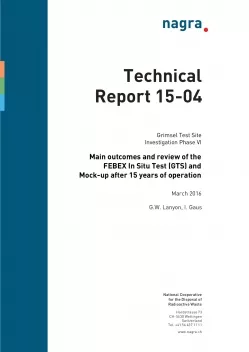
Technical Report NTB 15-04
Main outcomes and review of the FEBEX In Situ Test (GTS) and Mock-up after 15 years of operation
The main objectives of the Full-Scale Engineered Barriers Experiment (FEBEX) were to demonstrate the practicality of implementing a horizontal disposal concept for high-level waste (HLW) in a crystalline host rock, validate the performance of the engineered barrier system (EBS), and enhance the understanding of coupled thermo-hydro-mechanical (THM) and geochemical (THMC) processes in the engineered and natural barriers.
The key element of the FEBEX project is the full-scale In Situ Test at the GTS, where two heaters simulating HLW canisters were emplaced within a buffer of pre-compacted bentonite blocks. From the start of heating in 1997, a constant temperature of 100 °C was maintained at the heater surface while the bentonite buffer slowly hydrated with water from the granite host rock. The evolution of temperature, water saturation, relative humidity, total pressure, pore pressure and displacement was monitored by a total of 632 sensors placed in the bentonite buffer and the geosphere. In 2002, after five years of heating, the EBS around Heater # 1 was dismantled and characterised while Heater # 2 remained in operation.
As an independent reference, a ~ 1:3 scale Mock-up Test has been run under controlled laboratory conditions at CIEMAT in Madrid. In contrast to the In Situ Test, water in the Mock-up is supplied at constant pressure to the buffer via a geotextile to assure well-defined experimental boundary conditions. The sensor density in the Mock-up is significantly higher than in the In Situ Test. These two large-scale FEBEX tests are complemented by extensive laboratory and modelling programmes.
Over the fifteen years since emplacement the EBS has largely performed as expected. The major processes and couplings affecting the buffer saturation during the initial thermal period had been identified prior to the start of the experiment. Much of the buffer, in both the In Situ and Mock-up Tests, achieved high saturation and significant swelling pressures developed throughout the greater part of the buffer. Buffer inhomogeneity due to construction played a smaller role than expected and a relatively uniform axisymmetric thermal, saturation and stress response controlled by distance from the heater has been observed. For the In Situ Test, this implies that the saturation process has been controlled by the low permeability of the saturated bentonite rather than heterogeneity of the more permeable rock mass.
THM modelling has played a significant role in the FEBEX programme from the initial design studies through the experimental period. The success of the models in predicting the initial development and continued evolution of the In Situ Test and the Mock-up relies on the identification of the most significant processes, detailed laboratory characterisation of the buffer, the limited influence of buffer heterogeneity (e.g. construction joints), and for the In Situ Test, the lack of sensitivity to geosphere heterogeneity. However, the limits of modelling (and of the datasets from the large-scale tests) have also been identified in terms of the ability to discriminate between additional processes which may influence the final part of the saturation process.
A significant improvement in THC/THMC modelling of the clay barrier has been achieved during the FEBEX project. Throughout the course of the project, THC/THMC codes were developed which could handle the observed thermo-hydro-geochemical couplings and account for the most relevant features of the THC conceptual model.
In summary, the FEBEX In Situ and Mock-up Tests have provided a unique insight into the EBS evolution at a realistic scale and over a time frame of 15 years, covering a significant part of the early EBS evolution in a repository. Demonstration of the practicality of the concept was achieved within the first few years with the construction and operation of the In Situ Test. The development of a low permeability, highly saturated outer layer of the buffer with significant swelling pressures and the absence of any indication of preferential flow demonstrates the buffer's required performance over time as saturation increases. With the final dismantling of the In Situ Test in 2015, a wealth of information on the state of the buffer and on the action of corrosion, geochemical and microbial processes will be provided that extends the current process understanding of buffer evolution. The dataset will further constrain THM/THMC models and hence increase their long-term predictive capabilities.
